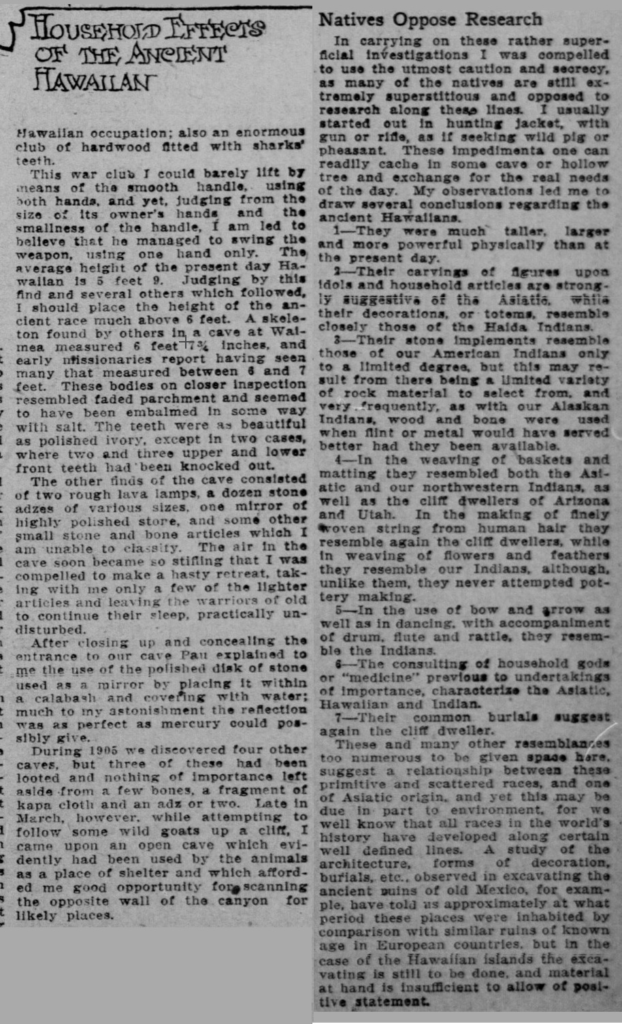Oahu Giants 6 – 7 Feet in Height
HOUSEHOLD EFFECTS OF THE ANCIENT HAWAIIAN
Hawaiian occupation; also an enormous club of hardwood fitted with sharks’ teeth.
This war club I could barely lift by means of the smooth handle, using both hands, and yet, judging from the size of its owner’s hands and the smallness of the handle, I am led to believe that he managed to swing the weapon, using one hand only.
The average height of the present-day Hawaiian is 5 feet 9. Judging by this find and several others which followed, I should place the height of the ancient race much above 6 feet. A skeleton found by others in a cave at Wamea measured 6 feet 7 1/2 inches, and early missionaries report having seen many that measured between 6 and 7 feet. These bodies on closer inspection resembled faded parchment and seemed to have been embalmed in some way with salt. The teeth were as beautiful as polished ivory, except in two cases, where two and three upper and lower front teeth had been knocked out.
The other finds of the cave consisted of two rough lava lamps, a dozen stone adzes of various sizes, one mirror of a highly polished stone, and some other small stone and bone articles which I am unable to classify.
The air in the cave soon became so stifling that I was compelled to make a hasty retreat, taking with me only a few of the lighter articles and leaving the warriors of old to continue their sleep, practically undisturbed.
After closing up and concealing the entrance to our cave, Pau explained to me the use of the polished disk of stone used as a mirror by placing it within a calabash and covering with water; much to my astonishment the reflection was as perfect as mercury could possibly give.
During 1905, we discovered four other caves, but three of these had been looted and nothing of importance left aside from a few bones, a fragment of kapa cloth, and an adz or two. In March, while attempting to follow some wild goats up a cliff, I came upon an open cave which evidently had been used by the animals as a place of shelter and which afforded me good opportunity for scanning the opposite wall of the canyon for likely places.
Natives Oppose Research
In carrying on these rather superficial investigations, I was compelled to use the utmost caution and secrecy, as many of the natives are still extremely superstitious and opposed to research along these lines. I usually started out in hunting jacket, with gun or rifle, as if seeking wild pig or pheasant. These impedimenta one can readily cache in some cave or hollow tree and exchange for the real needs of the day. My observations led me to draw several conclusions regarding the ancient Hawaiians.
- They were much taller, larger and more powerful physically than at the present day.
- Their carvings of figures upon idols and household articles are strongly suggestive of the Asiatic.
- While their decorations, or totems, resemble closely those of the Haida Indians.
- Their stone implements were used to a limited degree, resembling those of our American Indians only to a limited degree, but this may result from there being a limited variety of rock material to select from, and very frequently, as with our Alaskan Indians, wood and bone were used when flint or metal would have served better had they been available.
- In the weaving of baskets and matting, they resembled both the Asiatic and our northwestern Indians, as well as the cliff dwellers of Arizona and Utah.
- In the making of finely woven string from human hair, they resemble again the cliff dwellers, while in weaving of flowers and feathers they resemble our Indians,
- Their common burials suggest a relationship to the cliff dwellers.
These and many other resemblances, too numerous to be given space here, suggest a relationship between these primitive and scattered races, and one of Asiatic origin. Yet, this may be due in part to the environment, as we know that all races in the world’s history have developed along certain well-defined lines. A study of the architecture, forms of decoration, burials, etc., observed in excavating the ancient ruins of old Mexico, for example, has told us approximately at what period these places were inhabited, by comparison with similar ruins of known age in European countries. But in the case of the Hawaiian Islands, the excavating is still to be done, and the material at hand is insufficient to allow for positive statements.


- San Francisco Call, Volume 103, Number 99, 8 March 1908